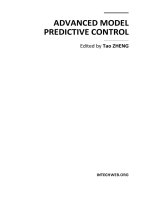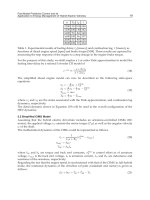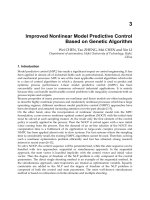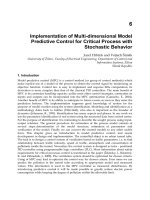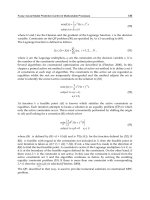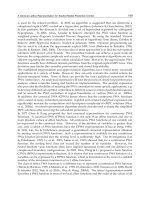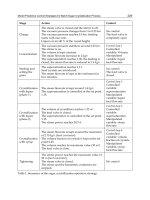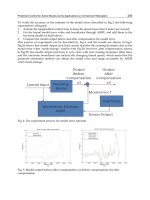Advanced Model Predictive Control Part 15 potx
Bạn đang xem bản rút gọn của tài liệu. Xem và tải ngay bản đầy đủ của tài liệu tại đây (1.68 MB, 10 trang )
BrainWave®: Model Predictive Control for the Process Industries
409
controller to minimize disturbances by adjusting outlet valve positions at the same time as
the inlet valve positions are changing. Fig. 10 provides a simple diagram illustrating the
application of the control loops.
Cell 1
LI
Cell 2
LI
Cell 1 Level
Controlle
r
Cell 2 Level
Controller
Adaptive MPC
Adaptive MPC
Pulp
Level Set
Point
Level Set
Point
Fig. 10. Diagram of flotation control strategy
The advanced control loops replaced the existing PID loops which the plant had previously
used to maintain cell level. The PID controllers had struggled to maintain tight control and
had particular difficulty stabilizing the cells after large disturbances or on plant start-ups.
Fig. 11 demonstrates the improvement to the cell level control that was achieved by
replacing traditional PID loops with the BrainWave loop controllers. In this case there was
as much as 60% reduction in level variability as measured by standard deviation.
It is suggested that improved level stability has the effect of improving mineral recovery,
improving product grade, and reducing frother consumption. However, these are difficult
benefits to prove, due to the problem in obtaining and collecting sufficient data, where the
comparisons can be made given the same operating conditions (for example, with the same
production rates and ore types). Unfortunately, to date, the plant has not been able to complete
such an analysis. However, one obvious and easily measurable benefit came from the
improved control performance on large production rate changes or plant start-ups. It was
observed that the PID controllers had difficulty in stabilizing the cells after these events; often
cell levels could swing for as much as two hours before settling into what could be considered
steady-state. This settling time was greatly reduced with the BrainWave controllers. The
benefits from avoiding this loss in operating time can be directly calculated. An example
calculation can be made based on the business fundamentals given in Table 2.
Tonnes Milled per Day 50,000
Copper Grade 0.3%
Recovery 75%
Tonnes Copper Produced 112.5
Pounds per Metric Tonne 2,205
Price per Pound $4.00
Production Cost $1.50
Daily Profit $620,156
Table 2. Example Mineral Concentrator Business Fundamentals
Advanced Model Predictive Control
410
If the BrainWave control reaches ‘steady state’ in one hour less than PID control, and there is
one of these large disturbances events per week, then this represents the equivalent of 2.2
more days of operating time per year. Based on daily revenue of $620,156, this gives an
increase in profit of $1.36 million annually.
Note that this is only the ‘easily’ calculated benefit and does not include the additional
benefits to be obtained through improvements in recovery. Even a modest 0.5 percentage
point increase in recovery from improved froth level control yields close to an additional
$1.1 million per year in profit.
MPC vs PID Control - Aug 10 (Cell 3)
0
5
10
15
20
25
30
35
40
6:14
6:21
6:28
6:34
6:41
6:48
6:54
7:01
7:08
7:14
7:21
7:28
7:34
7:41
7:48
7:54
8:01
8:08
8:14
8:21
8:28
8:34
8:41
8:48
8:54
3:26
3:40
3:53
4:06
4:20
4:33
4:46
5:00
5:13
5:26
5:40
5:53
6:06
6:20
6:33
6:46
7:00
7:13
7:26
7:40
10
12
14
16
18
20
22
24
26
28
30
< MPC Control >< PID Control >
Level - PV
CV - Valve
(data collected at 1 s) (data collected at 3 s)
BWC - PID Control (Cell 3)
0
0.2
0.4
0.6
0.8
1
1.2
1.4
-3
-2.8
-2.5
-2.3
-2
-1.8
-1.5
-1.3
-1
-0.8
-0.5
-0.3
-0
0.2
0.5
0.7
1
1.2
1.5
1.7
2
2.2
2.5
2.7
3
3.2
3.5
3.7
4
MPC
PID
St. Dev ISE
PID 0.79 0.63
MPC
0.31 0.09
Improv. 60% 84%
Fig. 11. Comparison of PID and BrainWave control of flotation level
5. Pulp and paper applications
Many processes involved in the manufacture of pulp and paper exhibit challenging dynamics
for control due to long reaction times. The pulp digester, which cooks the wood chips with
BrainWave®: Model Predictive Control for the Process Industries
411
sodium hydroxide to produce pulp, has a retention time of several hours. Many properties of
the pulp are affected by conditions in the digester so it is very important to maintain the
correct chip level, temperature profile, and chemical concentration throughout the cooking
process to produce pulp with uniform quality. The chemical recovery circuit is used to
regenerate the sodium hydroxide for use in the digester as part of a closed loop sodium cycle
known as the Kraft process. The chemical recovery system consists of a lime kiln and
recaustification process which is also a closed circuit that uses calcium carbonate and calcium
hydroxide to transform the sodium carbonate back to sodium hydroxide. This system has long
response times due to the large thermal mass in the kiln and the large retention time in the
causticizing reactors. The pulp bleaching stages also have long process retention times to allow
complete reaction of the pulp with the expensive bleaching chemicals. Finally, the pulp dryer,
which is a very large unit with a long residence time for the drying pulp, must be controlled to
maintain the final moisture content of the produced pulp.
Each of these processes present unique challenges for automatic control. The BrainWave
MPC controller has been successfully applied to these processes due to its ability to handle
the long response times of these systems.
5.1 Digester control
Optimal digester operation requires precise control of the wood chip levels in the steaming
bin, impregnation vessel, and the digester to maintain uniform residence time in the cooking
process. Chemical addition, as measured by effective alkali (EA) and digester temperature
profile must be constant to provide a consistent cook, or delignification, of the pulp as
measured by a Kappa index. Reducing variability of these process parameters yields a
corresponding reduction in Kappa variability. Precise Kappa control can reduce bleach plant
costs and is certain to improve the quality of the pulp.
The BrainWave controller is used to hold these critical digester variables on target. The
digester cooking control strategy is shown in Fig. 12. The level of the wood chips in the
Fig. 12. Digester control scheme
Advanced Model Predictive Control
412
digester is controlled by adjusting the flow of chips from the impregnation vessel (sluice
flow) into the digester, which is fed at the top of the column. Transport delay time as well as
delays in the digester level measurement, combined with the integrating level response,
create a difficult control problem.
The existing digester level control was based on a PID controller in the DCS. During large
disturbances, the operator assumed manual control to try and stabilize the level. The
BrainWave controller was able to reduce the standard deviation of the level by more than
50% and required much less intervention from the operator. Fig. 13 provides a comparison
of the control performance when using the existing DCS/Manual control approach and the
improved control achieved with BrainWave.
Fig. 13. Comparison of MPC vs. DCS control of digester level
5.2 Lime Kiln control
The lime kiln is used to convert calcium carbonate into calcium oxide (lime) for use in the
recaustification process that converts sodium carbonate to sodium hydroxide for use in the
digester. The properties of the lime are dependent on the temperature profile of the kiln. The
temperature profile is typically manually controlled due to the long time delays and
BrainWave®: Model Predictive Control for the Process Industries
413
multivariable interactions of the draft (air flow) and fuel on the kiln temperature profile that
make automatic operation with conventional PID controllers impractical. Response times of
one to three hours or more are typical. Operators are often impatient with the long response
time of this system and tend to make large corrections to the fuel feed rate in an attempt to
recover the temperature profile quickly during process disturbances such as production rate
changes. These actions result in extremes of temperature in the kiln, leading to poor lime
quality, ring formation problems, and reduced refractory life. Operators also tend to control
the temperature profile at a higher value than necessary for the lime burning and at a high
excess oxygen level to provide a comfortable operating margin that requires less frequent
attention. These practices lead to increased fuel consumption and maintenance costs.
Adjusting draft and fuel cause shifts in the flame length and excess oxygen levels. In
addition to the long response times, this interaction must also be addressed by the control
strategy to achieve responsive yet stable control performance. The ultimate objective of the
control strategy is to maintain a constant lime discharge temperature to ensure consistent
lime quality as measured by the residual calcium carbonate (un-burned lime) and reactivity
with water to produce calcium hydroxide (slaking rate).
A multivariable MIMO BrainWave controller is used to control the temperature and oxygen
level at the feed end of the kiln by adjusting the fuel and induced draft (ID) fan. A single
loop BrainWave controller is used to control the lime discharge temperature by adjusting
the target for the feed end temperature. This approach allows feed end temperature limits to
be easily included in the control strategy, as low temperatures can lead to plugging of the
lime mud feed and high temperatures can lead to equipment damage in the dust removal
system. A schematic of the control scheme is given in Fig. 14.
Fig. 14. Lime Kiln control scheme
A chart of the feed end temperature, oxygen level, and firing end temperature is shown in
Fig. 15 for both manual control and automatic control with BrainWave. A summary of the
performance improvements obtained by the BrainWave MPC controller on this application
is shown in Table 3. The range of variation of each process variable was substantially
reduced, allowing the kiln to operate at a lower average temperature with lower excess
oxygen. These improvements resulted in reduced fuel consumption, reduced incidence of
Advanced Model Predictive Control
414
ring formation, increased production capacity, and a better quality lime (as measured by
residual Calcium Carbonate CaCO
3
) as shown in Fig. 16. Based on the results of this
application, as well as experience with over 20 other similar applications, the control
improvements possible with MPC provide reductions in fuel consumption of 5% or more
while reducing lime quality variability by 50%.
Fig. 15. Lime Kiln control comparison
Process Variable Manual Control MPC Control Improvement
Excess Oxygen 1% 0.3% 70%
Feed Temperature 40ºF 7ºF 82%
Lime Temperature 200ºF 25ºF 87%
Table 3. Lime Kiln process variability comparison
BrainWave®: Model Predictive Control for the Process Industries
415
CaCO3 Residual Lab Results
Target 2.5 - 3.5
0
2
4
6
8
10
12
8:00 AM
12:00 AM
4:00 PM
8:00 AM
12:00 AM
4:00 PM
8:00 AM
12:00 AM
4:00 PM
8:00 AM
12:00 AM
4:00 PM
8:00 AM
12:00 AM
4:00 PM
8:00 AM
12:00 AM
4:00 PM
8:00 AM
12:00 AM
4:00 PM
8:00 AM
12:00 AM
4:00 PM
8:00 AM
12:00 AM
4:00 PM
8:00 AM
12:00 AM
4:00 PM
8:00 AM
12:00 AM
4:00 PM
8:00 AM
12:00 AM
4:00 PM
8:00 AM
12:00 AM
MPC Control
5 Days
Standard Control
Gas
20 Days
MPC
Gas
MPC
Oil
Switched from Gas to
Oil
High Target 3.5
Low Target 2.5
Fig. 16. Lime Kiln CaCO
3
residual laboratory results comparison
5.3 Pulp bleaching
The pulp bleaching process consists of several stages where bleaching chemicals are applied
to the pulp to increase brightness. These reactions occur in large towers with plug flow of
the pulp to allow long retention time for completion of the bleaching reaction. One of the
stages in the bleaching process is known as extraction stage where sodium hydroxide is
applied to the pulp to remove remaining lignin that was not removed in the digester. The
addition rate of the sodium hydroxide is controlled based on the pH at the exit of the
extraction stage as this measurement provides an indication if the correct amount of
chemical was applied. High pH values indicate that excess chemical was applied and can
result in damage to the pulp fibers and loss of pulp quality. Low pH values indicate that
insufficient chemical was applied resulting in less removal of lignin. The higher lignin
content will require additional expensive bleaching chemicals in the downstream stages in
order to achieve the target final pulp brightness.
Control of extraction stage after tower pH is challenging due to the long and varying dead
time, and that fact that the dead time and the process gain change significantly with
production rate. Due to the plug flow nature of the reaction tower, the process dead time for
the pH control is five times longer than the process time constant, making this control
application particularly difficult. The pH response to a change in addition rate of sodium
hydroxide had about two hours of dead time and a time constant of about 17 minutes.
As production rate changes affected these process dynamics significantly, the BrainWave
MPC controller was configured with a set of process models to cover the entire production
range. The main differences between the models were the process gain and dead time.
Process gain ranged from 0.6 to 2.0 and dead time ranged from 2,000 to 6,000 seconds.
Advanced Model Predictive Control
416
Lower production rates will require models with higher gain and longer dead time. As
production rate increases, model gain and dead time will decrease. The MPC controller
dynamically loaded the appropriate model according to the production rate as this provides
a faster solution in this case than relying on adaptation alone to correct for the changes in
the process. The mill had attempted to implement a Dahlin type controller but they had
difficulty keeping the process stable. The addition rate of sodium hydroxide was applied as
a ratio to the pulp production rate and the operator manually adjusted this ratio to maintain
the extraction pH in the correct range.
Fig. 17 shows the control performance achieved by the operator and the MPC control. Table
4 shows the comparison between the MPC control and manual control. The improved
control stability provided by the MPC control allowed operation at an average pH set point
of 10.2 instead of 10.5, resulting in a reduction of sodium hydroxide addition with
corresponding savings of about $100,000 per year.
Performance Index Manual Control MPC control Improvement
Standard Deviation 0.089 0.032 64%
Table 4. E Stage pH control improvement summary
Fig. 17. Extraction stage pH control comparison
5.4 Pulp dryer control
Pulp dryers are used to control the final moisture content of the pulp before it is shipped. The
moisture must not exceed a maximum specification limit so the dryer tends to be operated with
slightly over-dry pulp. This energy required for pulp drying can be reduced if the pulp
moisture can be controlled as close as possible to the specified limit. BrainWave MPC is ideally
suited to control the drying process due to its ability to account for the long transport delay time
as the pulp moves through the dryer to the moisture measurement sensor located at the dryer
exit. The MPC controller also provides an effective means to incorporate measured disturbance
variables such as sheet speed, broke flow, and pulp consistency as feed forward signals.
BrainWave®: Model Predictive Control for the Process Industries
417
Fig. 18. Pulp dryer control scheme
Fig. 19. Pulp dryer control performance comparison
Advanced Model Predictive Control
418
In addition to pulp moisture control, MPC was also used to control the pulp gramature (mass
of pulp per square meter) in the mat forming section at the feed end of the dryer. A diagram of
the pulp dryer control schematic is shown in Fig. 18. The pulp gramature is controlled by
adjusting the flow rate of pulp stock onto the wire section that forms the pulp mat. The final
pulp moisture is controlled by adjusting the steam pressure applied to the dryer sections.
In this example, the pulp dryer was part of a new pulp mill and was one of the largest pulp
dryers ever built. The existing Quality Control System (QCS) was used to control the pulp
moisture and gramature before the BrainWave MPC was installed. A comparison of the
moisture and gramature control performance is shown in Fig. 19. Standard deviation of the
pulp moisture and gramature was reduced by more than 50% compared to the QCS system.
With the improved stability, the average pulp moisture could be kept closer to maximum,
leading to increased production and energy savings.
6. Conclusions
In this chapter, the development and application of a Model Predictive Controller (MPC) has
been presented. It is clear that many industrial processes cannot be adequately controlled
using conventional Proportional-Integral-Derivative (PID) control techniques due to common
problems such as time delay and multivariable interactions. MPC exploits the abundance of
inexpensive computing power that is now available so the limitations of the old pneumatically
powered PID approach can be eliminated. MPC provides an opportunity to improve the
performance of most industrial processes in order to reduce production costs and
environmental impact, and improve product quality and profitability. These improvements
can be achieved much faster and at less capital cost compared to modifications or upgrades of
the process equipment resulting in an attractive return on investment.
7. Acknowledgements
The author would like to thank all the staff at Andritz Automation for their contributions to
the development and application of the BrainWave controller. The cooperation of customers
where this new technology has been installed is invaluable and the author is thankful for
their willingness to share the results of their work. ISA should also be acknowledged for
creating this book and making it available to the automation community.
8. References
Clarke, D.W., Mohtadi, C., & Tuffs, P.S. (1987). Generalized Predictive Control – Part I. The
Basic Algorithm”,
Automatica, Vol. 23, No. 2, 1987, 137-148.
Goodwin, G.C. & K.S. Sin, K.S. (1984).
Adaptive Filtering, Prediction and Control. Prentice-Hall Inc.
Huzmezan, M. (1998). Theory and Aerospace Applications of Constrained Model Based
Predictive Control. PhD thesis, University of Cambridge.
Salgado, M.E., Goodwin, G.C., & Middleton, R.H. (1988). Modified Least Squares Algorithm
Incorporating Exponential Resetting and Forgetting,
Int. J. Control, Vol. 47, No. 2,
477-491.
Wills, B.A. & Napier-Munn, T.J. (2006).
Wills’ Mineral Processing Technology, Butterworth-
Heinemann, Burlington, MA, USA.
Zervos, C.C. & Dumont, G.A. (1988). Deterministic Adaptive Control Based on Laguerre
Series Representation
, Int. J. Control, Vol. 48, No. 6, 2333-2359.
